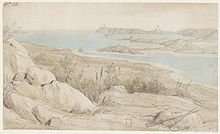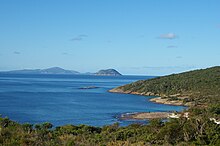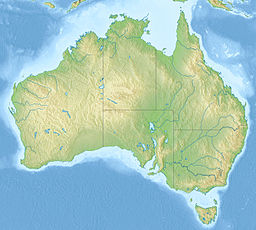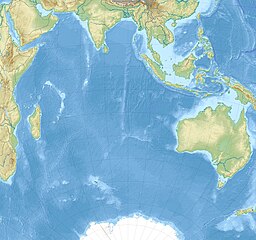King George Sound (Western Australia)
| King George Sound | |
|---|---|
King George Sound from Mount Clarence | |
| Coordinates | 35°02′S117°56′E/ 35.033°S 117.933°E |
| Type | sound |
| Part of | Indian Ocean |
| Surface area | 110 km2(42 sq mi) |
| Max. depth | 35 m (115 ft) |

King George Sound(MinengNyungar:Mammang-Koort[1][2]) is asoundon thesouth coast of Western Australia.NamedKing George the Third's Soundin 1791, it was referred to asKing George's Soundfrom 1805.[3]The name "King George Sound" gradually came into use from about 1934, prompted by newAdmiraltycharts supporting the intention to eliminate the possessive 's' from geographical names.[4]
The sound covers an area of 110 square kilometres (42 sq mi) and varies in depth from 10 to 35 metres (33 to 115 ft).[5]Situated at its western shore is the city ofAlbany.[6] The sound is bordered by the mainland to the north, by Vancouver Peninsula on the west, and by Bald Head and Flinders Peninsula to the south. Although the sound is open water to the east, the waters are partially protected byBreaksea IslandandMichaelmas Island.There are two harbours located within the sound,Princess Royal Harbourto the west andOyster Harbourto the north. Each receives excellent protection from winds and heavy seas. Princess Royal Harbour was Western Australia's only deep-water port for around 70 years until theFremantle Inner Harbourwas opened in 1897.[7]
History
[edit]











The first reported visit to King George Sound by a European was in 1791 by the English explorer CaptainGeorge Vancouver.Vancouver named itKing George the Third's Soundafter the reigning monarch.[8]
The next Europeans to visit the sound were Captain Dennis of theKingston,and Captain Dixson of theElligood.KingstonandElligoodwerewhalersand while there caught three whales. Dixson left an inscribed piece of copper plate behind.[9][10]
Matthew Flindersanchored in the sound from 8 December 1801 to 5 January 1802 and explored the area. While he was there, his men found the copper plate Dixson had left. During this timeRobert Brown(ship's botanist) andPeter Good(ship's gardener) collected samples of over 500 plant species.[11]
Nicolas Baudinarrived in the sound in February 1803 aboardLe Geographeto rendezvous withLouis de Freycinetaboard theCasuarinabefore doing further exploration of the Western Australian coastline.[12]During the course of their stay the ship's naturalistFrançois Péron,collected 1060 new species of shellfish and a large number of starfish from the sound.[13]
Phillip Parker Kingvisited the sound in 1818 aboard the cutterHMSMermaid[14]while en route to conduct a nautical survey of the North West Cape,[15]and FrenchmanDumont d'Urvillevisited it in 1826 aboard theAstrolabe.
On 25 December 1826, theNew South Walescolonial governmentbrigAmity,under the command of MajorEdmund Lockyer,arrived at King George Sound to establish a possessory military settlement.[16]Lockyer named his settlementFredrick Town[17][18][19]afterGeorge III's second son,Prince Frederick, Duke of York and Albany,but this name never gained wide acceptance.[20]Instead the settlement and surrounding locality were usually referred to as King George's Sound.
The settlement of King George's Sound was part ofNew South Wales– asemi-exclaveof New South Wales – from its establishment until 7 March 1831. It then was made part of theSwan River Colony,[21]which from 1833 has been known as Western Australia.
In 1832,Governor of Western AustraliaCaptain (later Admiral)James Stirlingdeclared the settlement a town and renamed itAlbany,but the broader locality continued to be referred to as King George's Sound for many years.[22]
In 1834Robert Dalepublished in London apanorama print of the viewfrom Mount Clarence accompanied by apamphlet describing the soundand the geography, geology, flora, fauna and native inhabitants of the immediate region.[23]
On 8 March 1836,HMSBeaglevisited King George Sound and anchored there for eight days. On board was the young naturalistCharles Darwin,who collected specimens on shore.Beaglewas on the homeward leg of her celebrated circumnavigation of the world, having already stopped off atSydney.
Until the construction ofFremantle Harbourin 1897, King George Sound contained the only deepwater port in Western Australia, and so was the favoured location for delivery of mail and supplies from abroad to Western Australia. These were then transported to Perth and Fremantle by road or coastal shipping until the early 1890s, when the completion of theGreat Southern Railwayprovided a quicker service.
Albany Portis located on the north shore of Princess Royal Harbour adjacent to the city ofAlbany.The port was first established in 1826 and has been expanded regularly since. The port now has five berths able to cater topanamaxclass vessels. The port typically caters for loading of about 120 vessels per annum.[24]
In 1914, King George Sound was the last Australian anchorage for the fleet taking the first Australian and New Zealand soldiers, later to become known asAnzacs,to Egypt. A memorial to the Anzacs of theDesert Mounted Corpshas been established on top ofMount Clarence.Albany was where the first commemorative dawn service was held onAnzac Day,25 April 1923. The contribution ofMustafa Kemal Atatürk,president of Turkey from 1923 until 1938 is recognised by naming the entrance into Princess Royal Harbour asAtatürk Entrance.[25]
There is evidence that shore-based bay whaling was carried out in Barker Bay, by James Daniels, as early as 1849.[26]Whaling ships from Hobart also visited the area in the 2nd half of the 19th century. TheCheyne Beach Whaling Companybegan operating out of Frenchman Bay, located within the sound, in 1952 with a small quota of 50 humpback whales that was eventually increased to 175.[27]At the peak of the whaling activity in the sound the company was taking between 900 and 1100spermandhumpback whalesin a year. Humpback whaling was banned in 1963 which in turn decreased the viability of the operation.
In 1978 the Cheynes Beach Whaling Company closed down after increasing environmental lobby group pressure. It was Australia's last coastal whaling company.[28]
Installation of ashark barrierwas commenced and completed in March 2016 atMiddleton Beach[29]at the north western end of the sound.
Flora
[edit]Denseseagrassbeds still exist in King George Sound, although they have been adversely affected by increased nutrient levels and industry in the area. Some of the seagrasses present in the sound includePosidonia australis,Posidonia robertsoneae, Posidonia kirkmanii, Posidonia sinuosa, Posidonia denhartogii,Posidonia ostenfeldii,Amphibolis antarctica,Amphibolis griffithii,Halophila australis,Halophila ovalis,Ruppia megacarpaandHeterozostera tasmanica.[30]
The fringing vegetation around the sound includes both the saltmarshes of Oyster Harbour and Princess Royal Harbour, and the sandy beach vegetation. Saltmarshes contain a variety of species includingsamphire,seablite,astartea,wattle,greenbush, shore rush, twig rush andsaltwater paperbark.[31] Freshwater species also occur in areas where substantial freshwater seepage occurs. Sandy beach areas contain a mix of shrubs and sedges such as the grey white cushion bush, coast sword sedge, knotted club rush, sea rocket, pigface and false caper.
Fauna
[edit]The sound comprises a wide variety of habitats that supports an abundance of marine life. Many species ofcoralsare present including Turbinaria frondens, Turbinaria mesenterina and Turbinaria renformis which cover an extensive area. Other coral species that can be found include Scolymia australis, Plesiastrea versipora, Coscinaraea mcneilli and Coscinaraea marshae.[32]
A large, wild mussel population was known to exist in the sound, and now commercial mussel farms operate within the area that grow and harvestBlue mussels.[33]
It is estimated that 203 species of fish inhabit the Oyster Harbour, Princess Royal Harbour and King George Sound, with AustralianpilchardsSardinops sagax neopilchardusmaking up 97% of the total fish catch.[34]Other species that are commonly found includeAustralian herring,leatherjackets, cobbler, tailor, Australian anchovy, garfish, sand trevally, tarwhine, flathead, tuna, snapper, Australian salmon, yellowtail scad, sea mullet, striped trumpeter, long-toothed flounder, dusky morwong and long-finned goby.[35]TheKing George whiting(Sillaginodes punctatus) was first named byCuvierin 1829 asSillago punctata,based on an individual taken from King George Sound.[36]
Sealsare known to inhabit the sound in various locations along the coast and on the islands. The species that are sighted most often are theAustralian sea lionand theNew Zealand fur seal.Species that have been sighted, but are considered to be occasional visitors, include thesubantarctic fur sealand theleopard seal.[34]
Dolphinsare also found in the area, and are occasionally caught and drowned in fishing nets[37]or stranded.[38]Thecommon dolphinDelphinus delphisand thebottlenose dolphinTursiops truncateshave both been recorded in the area.
Southern right whalesandhumpback whalesfrequent the area between July and October when they congregate to mate and calve in the protected waters of the sound.[39]Other whales that have been spotted in the area includeminke whales,blue whales,[40]short-finned pilot whales,false killer whalesandkiller whales.[34]Sperm whaleswere known to visit the sound during the whaling era but none have been sighted recently, although a pod was detected further out in the Southern Ocean in 2002.[41]
The sound becomes a perfect habitat for migratory wading birds during the summer, when an estimated 2,000-3,000 birds flock to the area to feed in the shallow mudflats of the harbours.[42]Some of the species that can be found during the summer months include thered-necked stintand thered knot[43]as well assandpipers,grey plovers,red capped plovers,lesser sand plovers,grey-tailed tattlers,Eurasian whimbrels,common greenshanks,yellow-billed spoonbill,white-faced heronandstilts.[44][45]Other birds that are commonly seen around the sound includecormorants,pied oystercatchers,sooty oystercatchers,Pacific gulls,Caspian terns,pelicans,ospreysandwhite-bellied sea eagles.
Geology
[edit]
The Western Australian south coast is formed along the edge of the southern margin of theYilgarn cratonand is fringed with prominent headlands composed ofgraniteandgneissesformed during Proterozoic tectonic activity.ArcuateBays that contain beaches backed byholocenedunes are found between the headlands.[46]
King George Sound includes many islands and some islets, all comprisinggranitoidrocks with accumulations of soil on most.
Islands of note includeBreaksea Island,Michaelmas Island,Seal Island,Mistaken Island,andGreen Island. .
Oceanography
[edit]
The tidal range in King George Sound (including Princess Royal Harbour and Oyster Harbour) is 0.4 metres (1 ft)[47]with spring tidal range of 1.1 metres (4 ft).[48]Tidal levels can remain static for periods of time. Semi-diurnal tides are frequent and diurnal tides are occasional.
The temperature of the water in the sound is slightly different from that of the open sea.
| Location[49] | Mean summer temp (°C) | Mean winter temp (°C) |
|---|---|---|
| Open sea | 20.1 | 17.3 |
| King George Sound | 20.5 | 13.6 |
Thesalinitylevel within the Sound remains relatively constant ranging between 34.8 and 35.5 '‰',[50]the lower levels occurring during heavy winter rain events when large volumes of freshwater enter the sound from theKingandKalgan rivers.
TheLeeuwin Currentexerts some influence in the sound as it flows eastwards along thecontinental shelfin the main part of the sound.[51]
Modern Representation
[edit]The region of King George sound was featured in Kim Scott's 2010 novel, 'That Deadman Dance', which describes interaction and colonialism in 'the friendly frontier'. The story follows a number of nuanced characters, both of European and indigenous Noongar heritage. The main settlement, King George Town, at the time of the book is described as a 'fledgling Australian town', which features a series of small residences and a public house owned by former soldier Alexander Killam.
Shipwrecks
[edit]Many wrecks exist within King George Sound. The most recent and best known is the 133 metres (436 ft) guided missiledestroyerHMAS Perth,which was scuttled in 2001 in 35 metres (115 ft) of water offSeal Island,to be used as a dive-site.[52][53]
The former whale chaserCheyneswas sold for scrap in 1961 and was subsequently sunk between Michaelmas Island and the northern shoreline of the sound. Another chaser in the fleet,Cheynes II,was blown ashore on Geak Point nearQuaranupin Princess Royal Harbour in 1990 and is still there, approximately 290 metres (951 ft) off-shore.[54][55]
TheLady Lyttletonsank in the Emu Point channel when repairs were attempted in 1867.[56]
A Hobart wooden barque, theFanny Nicholsonwas being used as a whaling vessel when it ran ashore during a gale in 1872. The remains can still be seen in shallow water inFrenchman Bay.Another Tasmanian whaling barque, theRunnymede,met a similar fate when it ran aground during a storm in 1881.[57]
Two wrecks within the sound are protected under the federalHistoric Shipwrecks Act 1976.These are the wooden barqueAthenathat sank in 1908, and the wooden boatElviethat sank in 1923.[58]
In 1868,Northumberland,a wooden barque laden with 2000 tonnes of coal, grounded on a reef off Bald Head near the entrance to King George Sound. The ship was freed and sailed into the sound with a broken rudder, the crew eventually abandoned ship and took to the life boats.Northumberlandfoundered and sank between Cape Vancouver andBreaksea Island.
Gallery
[edit]-
South side of King George's Sound, by Westall
-
Part of King George III Sound, December 1801,by Westall
-
Michaelmas Island as viewed from Mount Clarence
-
Mistaken Island from near Goode Beach
-
Seal Island from near Goode Beach
-
Green Island from Bayonet Head
See also
[edit]References
[edit]- ^Dobson, John (3 July 2020)."Albany, WA's oldest colonial settlement, to officially adopt joint Noongar names".Australia: ABC News.Retrieved9 July2022.
King George Sound, known as Menang Koort to the Noongar people, meaning "heart of the whale".
- ^"Restoring Menang Noongar Place Names - Central"(PDF).City of Albany.
- ^"SHIP NEWS".The Sydney Gazette and New South Wales Advertiser.Vol. 3, no. 137. New South Wales. 13 October 1805. p. 2.Retrieved9 July2022– via National Library of Australia.
- ^"What Is the Right Name?".Perth WA: The West Australian. 29 October 1935. p. 15.Retrieved31 August2014.
- ^"Albany Waterways Resource Book: King George Sound".2000.Retrieved9 November2010.
- ^"King George Sound".Gazetteer of Australia.Geoscience Australia.Archived fromthe originalon 4 June 2011.Retrieved18 February2007.
- ^"The Fremantle Harbour. The S.S. Sultan at the South Quay".The West Australian.5 May 1897. p. 2.Retrieved30 November2013.
- ^"Australias Southwest – Explorers and Settlement of Albany".2005. Archived fromthe originalon 8 September 2014.Retrieved20 April2008.
- ^"Australia on the map – The AOTM Landings List".2005. Archived fromthe originalon 3 April 2008.Retrieved20 April2008.
- ^"To King George the Third Sound for Whales".2007. Archived fromthe originalon 23 February 2011.Retrieved9 November2010.
- ^Flinders, Matthew(1814).A Voyage to Terra Australis.Vol. 1. London: G. & W. Nicol. pp. 53–74.
- ^"Encounter 1802-2002 Baudins Voyage".2002.Retrieved20 April2008.
- ^"ABC – The Naturalists".Australian Broadcasting Corporation.2008.Retrieved20 April2008.
- ^"175th Anniversary of WA – Albany".2004. Archived fromthe originalon 5 October 2007.Retrieved23 April2008.
- ^"King, Phillip Parker (1791–1856)".Australian Dictionary of on-line Biographies.National Centre of Biography, Australian National University. 2006.Retrieved24 April2008.
- ^Appleyard, R. T. and Toby Manford (1979).The Beginning: European Discovery and Early Settlement of Swan River Western Australia.Nedlands, Western Australia: University of Western Australia Press.ISBN0-85564-146-0.
- ^Nind, Isaac Scott(7 February 1828)."View of Frederick Town, King Georges Sound, at the expiration of the first year of its settlement".Manuscripts, Oral History and Pictures.State Library of New South Wales.Retrieved12 May2014.
- ^Nind, Isaac Scott(1832)."Description of the Natives of King George's Sound (Swan River Colony) and Adjoining Country".The Journal of the Royal Geographical Society of London.1:21–51.doi:10.2307/1797657.JSTOR1797657.Retrieved12 May2014.
- ^Wilson, Thomas Braidwood(1835). "Formation of the Settlement at King George's Sound".Narrative of a Voyage Round the World.London: Sherwood Gilbert & Piper. p. 281.Retrieved12 May2014.
- ^Statham – Drew, Pamela (2003).James Stirling: Admiral and Founding Governor of Western Australia.Nedlands, Western Australia: University of Western Australia Press.ISBN1-876268-94-8.
- ^"King George's Sound Settlement".State Records.State Records Authority of New South Wales.Archived fromthe originalon 17 May 2014.Retrieved14 May2014.
- ^"King George's Sound Settlement".State Records.State Records Authority of New South Wales.Archived fromthe originalon 17 May 2014.Retrieved14 May2014.
- ^Dale, Robert(1834).Descriptive Account of the Panoramic View &c. of King George's Sound and the Adjacent Country.London: J. Cross and R. Havell.
- ^"Albany Port Authority – Port Trade".2010. Archived fromthe originalon 2 November 2010.Retrieved22 August2010.
- ^"The Commonwealth – Response to call to arms. Troopships at Albany. Memorable event. Departure from Australia".Perth, WA: The West Australian. 19 November 1914. p. 7.Retrieved1 September2014.
- ^Martin Gibbs,The Shore Whalers of Western Australia: Historical Archaeology of a Maritime Frontier,Sydney University Press, 2010, p.143.
- ^"Whalemen Adventurers".2005.Retrieved25 May2008.
- ^"Pannell Discussions – Australia's position on whaling".2004. Archived fromthe originalon 20 July 2008.Retrieved26 May2008.
- ^Talitha Wolfe (2 March 2016)."Shark barrier work under way".The West Australian.Yahoo7.Retrieved22 August2016.
- ^"Aussie Heritage King George Sound".2007.Retrieved24 April2008.
- ^"Animals and plants of the Albany waterways".2002.Retrieved24 April2008.
- ^"Aussie Heritage King George Sound".2007.Retrieved27 April2008.
- ^"WA Department of FisheriesFarming Blue Mussels".2000. Archived fromthe originalon 26 July 2008.Retrieved27 April2008.
- ^abc"Albany Port Expansion Proposal – The Environment"(PDF).2007. Archived fromthe original(PDF)on 21 August 2008.Retrieved27 April2008.
- ^"Albany Waterways Resource Book – Animals and plants of the Albany waterways".2002.Retrieved9 November2010.
- ^McKay, R.J. (1992). FAO Species Catalogue: Vol. 14. Sillaginid Fishes Of The World. Food and Agricultural Organisation. pp. 19–20. ISBN 92-5-103123-1
- ^"Common Dolphin stranding, King George Sound".1989.Retrieved27 April2008.
- ^"Common Dolphin stranding, Between King George Sound and Princess Royal Harbour".1985.Retrieved27 April2008.
- ^"Australia's South West – Whales – Where to Look".2007. Archived fromthe originalon 7 May 2008.Retrieved27 April2008.
- ^"Whale Adventure Tours".2008.Retrieved27 April2008.
- ^"The Voyage of the Odyssey".PBS.2002.Retrieved27 April2008.
- ^"Aussie Heritage – King George Sound".2007.Retrieved30 April2008.
- ^"Aussie Heritage – Oyster Harbour".2007.Retrieved30 April2008.
- ^"Albany Waterways Resource Book – How waterways work in the Albany area".2007.Retrieved9 November2010.
- ^"Albany Gateway – Albany Bird Group".2007.Retrieved9 November2010.
- ^"Interim Marine and Coastal Regionalisation for Australia"(PDF).1998. Archived fromthe originalon 3 August 2008.Retrieved2 May2008.
- ^"Physical characteristics of Albany Waterways".2002.Retrieved9 November2010.
- ^"Albany Port Expansion Proposal – Hydrodynamics and Sedimentation"(PDF).2007. Archived fromthe originalon 20 July 2008.Retrieved17 May2008.
- ^"Albany Waterways Resoucre book – King George Sound".2002.Retrieved9 November2010.
- ^"Grange Resources – Albany Port Expansion Proposal – Marine Sedimant and Water Quality"(PDF).2002. Archived fromthe originalon 20 July 2008.Retrieved17 May2008.
- ^Fletcher, WJ; Tregonning, RJ (1992)."Distribution and timing of spawning by the Australian pilchard (Sardinops sagax neopilchardus) off Albany, Western Australia".Marine and Freshwater Research.43(6): 1437.doi:10.1071/mf9921437.Retrieved24 May2008.
- ^"The best artificial reefs of Western Australia".2007. Archived fromthe originalon 14 May 2008.Retrieved24 May2008.
- ^"Albany's Dive Wreck – The former HMAS Perth".2007. Archived fromthe originalon 26 May 2008.Retrieved24 May2008.
- ^"History of Cheynes Beach Whale chasers".2005. Archived fromthe originalon 14 February 2008.Retrieved26 May2008.
- ^"Bonzle Maps – Map of Cheynes II Wreck, WA".2007.Retrieved26 May2008.
- ^"Lady Lyttleton (1867/07/17) Albany, Oyster Harbour, Emu Point Channel".Shipwreck Databases.Western Australian Museum.Retrieved4 January2016.
- ^"Shipwrecks of the Southern Coast"(PDF).2008.Retrieved9 November2010.
- ^"Albany Port Expansion Proposal – Social and Cultural Environment"(PDF).2008. Archived fromthe original(PDF)on 20 July 2008.Retrieved25 August2008.
External links
[edit]![]() Media related toKing George Soundat Wikimedia Commons
Media related toKing George Soundat Wikimedia Commons









